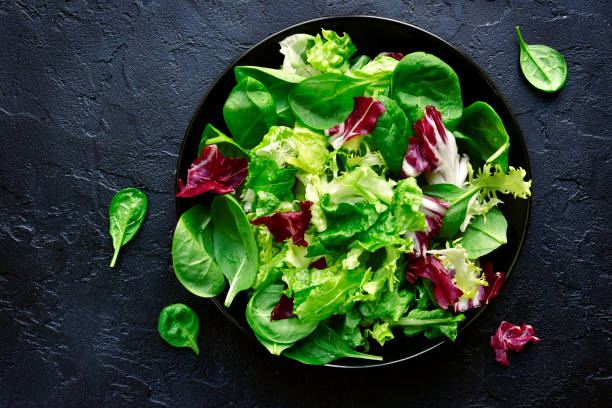As we enter Spring and everything starts budding, it is a perfect time to discuss leafy greens. Leafy greens are edible leaves from plants and can be tender and soft, or tougher with a thick stem. Some examples include collards, Swiss chard, arugula, spinach, lettuce, kale, mustard greens, turnip greens, bok choy, and romaine.
Leafy greens pack a lot of nutrients, specifically dark leafy greens. Kale, an example of a dark leafy green, is an excellent source of vitamins K, A, C, and calcium. One cup of chopped kale is 90% the daily recommended intake of vitamin C. Vitamin C plays a role in maintaining healthy skin and wound healing. It is used to make collagen for connective tissues in the body and is also an antioxidant that helps with inflammation. Kale can be eaten raw, though be sure to cut out the center stem, or sautéed. The center stems can be cut out, diced, and sautéed with onion before the leaves are added so that it has more time to cook. Since it is one of the tougher greens, kale holds up well in soups and stews.
Spinach, another dark leafy green, is softer than kale and cooks down quickly. For this reason, it is best to add it into a dish right before the end of cooking since it only takes a couple of minutes to cook. Spinach is also a great addition to quiches, sandwiches, smoothies, omelets, and pastas. Spinach contains vitamins A and C as well as potassium, calcium, and iron. One cup of spinach contains over 300% the recommended intake of vitamin A. Vitamin A is important for eye function and regulating cell growth and division.
Swiss chard is another excellent dark leafy green that contains vitamins K, A, C, and magnesium. One cup of chopped Swiss chard contains over 300% of the daily value for vitamin K. Vitamin K is needed for blood clotting. It also plays a role in binding calcium in bones. Like kale, Swiss chard has a thicker middle stalk. Rainbow Swiss chard has red, yellow, white, and green stalks. Swiss chard can be eaten raw in a salad, used as a wrap, sautéed, or boiled.
Collard greens can be one of the toughest dark leafy greens out there, which is why they are commonly slow-cooked for preparation. Collards contain almost 300% of the daily value of vitamin A in one cup and about half of the daily value for vitamin C. Like kale, they hold up well in soups and stews, and the sturdy leaves work well for wraps after a quick blanching.
Along with the many vitamins listed above, greens are an excellent source of fiber, which is helpful for slowing digestion, regulating bowel movements, and aiding in lowering cholesterol. Leafy greens are a perfect addition to any meal and pack a nutritious punch. Try adding them to a dish, salad, or side like the Sauteed Collard Greens & Garlic recipe found on Click ‘N Cook!
Written by:
Ellie Goddard, Dietetic Intern


